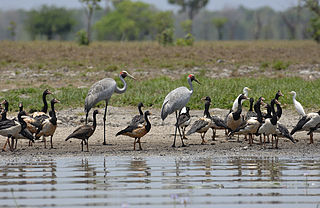
Gehyra is a genus of geckos, lizards in the family Gekkonidae. Species within the genus are known as web-toed geckos or dtellas, and most bear close resemblance to geckos from the genus Hemidactylus.

The Top End of Australia's Northern Territory is a geographical region encompassing the northernmost section of the Northern Territory, which aside from the Cape York Peninsula is the northernmost part of the Australian continent. It covers a rather vaguely defined area of about 245,000 square kilometres (95,000 sq mi) behind the northern coast from the Northern Territory capital of Darwin across to Arnhem Land with the Indian Ocean on the west, the Arafura Sea to the north, and the Gulf of Carpentaria to the east, and with the almost waterless semi-arid interior of Australia to the south, beyond the huge Kakadu National Park.
Allosyncarpia ternata, commonly known as an-binik, is a species of rainforest trees constituting part of the botanical family Myrtaceae and included in the eucalypts group. The only species in its genus, it was described in 1981 by Stanley Blake of the Queensland Herbarium. They grow naturally into large, spreading, shady trees, and are endemic to the Northern Territory of Australia. They grow in sandstone gorges along creeks emerging from the Arnhem Land plateau.
Cycas arnhemica is a species of cycad in the genus Cycas, native to Australia, in the northwest of Northern Territory in Arnhem Land, after which it is named.

The Oenpelli python or Oenpelli rock python is a species of large snake in the family Pythonidae. The species is endemic to the sandstone massif area of the western Arnhem Land region in the Northern Territory of Australia. There are no subspecies that are recognised as being valid. It has been called the rarest python in the world. Two notable characteristics of the species are the unusually large size of its eggs and its ability to change colour. It is the longest snake native to the Northern Territory.
The Arnhem Land rock rat also known as the Arnhem rock-rat and by the Indigenous Australian name of kodjperr is a species of rodent in the family Muridae. It is found only in the Top End Region of the Northern Territory in Australia.
Utricularia arnhemica is an affixed aquatic or terrestrial carnivorous plant that belongs to the genus Utricularia. It is endemic to the Arnhem Land area in the Northern Territory of Australia.

Gehyra australis, the Australian house gecko, northern dtella or top-end dtella, is a species of gecko native to northern and eastern Australia. It is also widespread in Indonesia, alongside common house geckos and four-clawed geckos.

The Arnhem Land tropical savanna is a tropical and subtropical grasslands, savannas, and shrublands ecoregion in Australia's Northern Territory.

The Arnhem leaf-nosed bat is a species of bat in the family Hipposideridae. It lives in the sandstone areas of Kakadu National Park.

Blue Mud Bay is a large, shallow, partly enclosed bay on the eastern coast of Arnhem Land, in the Northern Territory of Australia, facing Groote Eylandt on the western side of the Gulf of Carpentaria. It lies 580 km (360 mi) east-south-east of Darwin in the Arnhem Coast bioregion. Its name was given to a landmark court ruling affirming that the Aboriginal traditional owners of much of the Northern Territory's coastline have exclusive rights over commercial and recreational fishing in tidal waters overlying their land.

Gehyra pamela, also known commonly as the Arnhemland watercourse dtella or the Arnhem Land spotted dtella, is a species of gecko, a lizard in the family Gekkonidae. The species is endemic to the Northern Territory in Australia.
Gehyra pulingka is a species of gecko endemic to Australia. It occurs in north-west South Australia, the mid Northern Territory, and Western Australia to the eastern Rawlinson Ranges. It is described as being generally dark-skinned with a pattern of light and dark markings over its body; however, light-skinned variants with similar patterns have been found.
The North West Cape gehyra is a species of gecko in the genus Gehyra. It is endemic to Western Australia. It was first described in 2018.
The Hamersley Range spotted gehyra is a species of gecko in the genus Gehyra. It is endemic to Western Australia. It was first described in 2018.
The Gulf tree gehyra is a species of gecko, also known as the ghost gecko. It is endemic to Queensland, and to the Northern Territory in Australia.
Hibbertia arnhemica is a species of flowering plant in the family Dilleniaceae and is endemic to Arnhem Land in the Northern Territory. It is an erect shrub with hairy branchlets, egg-shaped or elliptic leaves and spikes of eight to fifteen yellow flowers, each with twenty to thirty stamens arranged on one side of the two carpels.
Hovea arnhemica, is a species of flowering plant in the family Fabaceae and is endemic to the Top End of the Northern Territory. It is a subshrub with light brown hairs, narrowly egg-shaped or elliptic leaves with stipules at the base, and mostly white, pea-like flowers.
Jacksonia arnhemica is a species of flowering plant in the family Fabaceae and is endemic to the Northern Territory. It is an erect, densely branched, delicate shrub, the end branches sharply-pointed phylloclades, with yellow flowers, and woody, hairy pods.

Dodonaea arnhemica is a species of plant in the family Sapindaceae and is endemic to the north of the Northern Territory. It is a shrub with oblong or elliptic leaves, flowers arranged singly or in racemes, and capsules with four or five broad wings.








